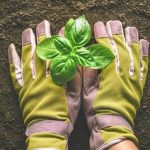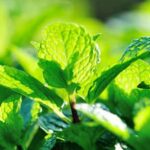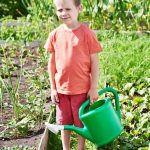Are you interested in growing your own herbs and vegetables but don’t have a lot of outdoor space? Container gardening may be the perfect solution for you. In this article, we will explore the benefits and appeal of container gardening for herbs and vegetables, as well as provide a comprehensive guide to getting started.
Container gardening allows individuals with limited outdoor space or no garden at all to still enjoy the rewards of growing their own fresh herbs and vegetables. Whether you live in an apartment, condominium, or simply have a small backyard, you can create a thriving garden with the right containers and care. With the right knowledge and tools, anyone can cultivate a bountiful harvest of herbs and vegetables right on their patio or balcony.
In this article, we will cover everything you need to know to get started with container gardening for herbs and vegetables. From choosing the right containers and essential tools, to selecting the ideal plants and maximizing limited space, we will provide expert advice to help you create a successful and rewarding container garden. Whether you are new to gardening or a seasoned pro, container gardening offers endless possibilities for growing your own fresh produce right at home.
Choosing the Right Containers
When it comes to container gardening for herbs and vegetables, choosing the right containers is crucial for the optimal growth of your plants. There are a variety of options to consider, including clay pots, plastic containers, wooden planters, and fabric grow bags. Each type of container has its own unique benefits and considerations, so it’s important to select the best option for your specific needs.
Clay pots are a popular choice for container gardening because they are porous, allowing air and moisture to pass through the walls of the pot. This can help prevent overwatering and root rot. However, they can be heavy and break easily if not handled with care. Plastic containers are lightweight and durable, making them a practical choice for beginners. They come in a wide range of sizes and styles, offering versatility for different types of herbs and vegetables.
Wooden planters add a natural aesthetic to your container garden and can be custom-built to fit your space. They provide good insulation for plant roots but may need additional waterproofing to prevent rot. Fabric grow bags are lightweight, breathable, and allow for excellent drainage. They are also easy to store when not in use and promote air pruning of roots for healthier plants.
In addition to selecting the right type of container, it’s important to consider size. Most herbs can thrive in smaller containers, while vegetables like tomatoes or peppers require larger pots or containers with sufficient depth for their root systems to develop properly.
| Container Type | Advantages |
|---|---|
| Clay Pots | Porous material prevents overwatering; good airflow |
| Plastic Containers | Lightweight; durable; versatile sizes |
| Wooden Planters | Natural aesthetic; good insulation; customizable |
| Fabric Grow Bags | Lightweight; breathable; excellent drainage |
By carefully selecting the right containers based on these considerations, you can set up your herbs and vegetables for successful growth in a container garden.
Essential Tools and Supplies
Container gardening for herbs and vegetables offers a convenient and compact way to grow your own fresh produce, even with limited space. To ensure successful container gardening, it’s essential to have the right tools and supplies on hand. Here are some necessary items that every container gardener should have:
1. Containers: Choose containers that provide adequate drainage and enough space for the roots of your plants to grow. Options include plastic, ceramic, or terracotta pots, as well as fabric or hanging planters.
2. Potting mix: Use a high-quality potting mix specifically designed for container gardening. Avoid using regular garden soil, as it may not provide the necessary nutrients and drainage.
3. Watering can or hose: Proper watering is crucial for container gardening success, so make sure you have a watering can or hose with a gentle spray attachment.
4. Hand tools: Keep small hand tools such as a trowel, pruners, and a hand fork for planting, pruning, and maintaining your container garden.
5. Fertilizer: Choose a fertilizer suitable for herbs and vegetables in containers. Consider organic options for a more natural approach to feeding your plants.
In addition to these basic supplies, consider investing in a moisture meter to help monitor the moisture levels in your containers accurately. With the right tools and supplies at your disposal, you’ll be well-equipped to create a thriving herb and vegetable garden in containers.
| Essential Tools | Essential Supplies |
|---|---|
| Containers | Potting mix |
| Watering can or hose | Hand tools |
| Fertilizer |
Selecting the Ideal Herbs
When it comes to selecting the ideal herbs for container gardening, there are several options that thrive in this environment. Some of the best herbs to grow in containers include basil, mint, parsley, chives, and thyme. These herbs are not only popular for their culinary uses, but they also do well in confined spaces and can be easily grown on a windowsill or patio.
Care Requirements for Herbs
Herbs typically require well-draining soil to prevent waterlogged roots, so it is important to choose a potting mix specifically designed for herbs. Additionally, most herbs prefer full sun, so be sure to place your containers in a location where they will receive at least 6-8 hours of sunlight per day.
It is also essential to regularly water your herb containers to keep the soil consistently moist but not waterlogged. Finally, regular pruning and harvesting of your herbs will promote new growth and ensure healthy plants.
Ideal Containers for Herbs
When choosing containers for growing herbs, opt for pots that are at least 6-12 inches deep to accommodate the root systems of most herbs. Containers with drainage holes are essential to prevent waterlogging and root rot. Consider using decorative pots that complement your outdoor space or kitchen decor. Furthermore, consider grouping different types of herbs together in larger containers or using smaller individual pots for each herb variety.
Growing Vegetables in Containers
When it comes to growing vegetables in containers, many options are available for those looking to dabble in container gardening. Not all vegetables are suited for this type of gardening, but there is a variety that thrives in containers and produces bountiful harvests. Some popular vegetables that do well in containers include:
- Cherry tomatoes: These small, sweet tomatoes are perfect for container gardening, and there are many compact varieties available.
- Bell peppers: Colorful and tasty, bell peppers can flourish in containers with proper care and maintenance.
- Lettuce: With shallow roots, lettuce is an ideal choice for container gardening, especially for those who enjoy fresh salads.
- Green beans: Bush varieties of green beans can produce a generous yield in containers without needing much space.
When growing vegetables in containers, it’s essential to provide them with the right care and maintenance. Proper watering, soil quality, sunlight exposure, and pest control are crucial factors to consider. Regularly check the moisture level of the soil and ensure that it doesn’t dry out completely.
Additionally, using high-quality potting mix specifically designed for container gardening can help provide the necessary nutrients for vegetable plants. In terms of sunlight, most vegetable plants require at least 6 hours of direct sunlight daily for optimal growth. Finally, keep an eye out for pests and diseases that may affect your vegetables and take appropriate measures to control them.
By choosing the right vegetables and providing them with proper care and maintenance, you can successfully grow a thriving container garden filled with delicious and nutritious produce right at your fingertips. Whether you have limited outdoor space or simply want the convenience of having fresh vegetables close by, container gardening offers a versatile and rewarding way to grow your own food.
Tips for Successful Container Gardening
When it comes to successful container gardening, there are a few key factors to consider in order to ensure the health and growth of your herbs and vegetables. From proper watering techniques to the right type of soil, sunlight requirements, and pest control, these expert tips will help you navigate the ins and outs of container gardening.
Watering
One of the most crucial aspects of container gardening is proper watering. Since containers often dry out more quickly than traditional garden beds, it’s important to monitor the moisture levels regularly. The rule of thumb for watering herbs and vegetables in containers is to keep the soil consistently moist but not waterlogged. This may require more frequent watering, especially during warmer months or if your containers are exposed to direct sunlight for long periods.
Soil
The type of soil you use in your containers can greatly impact the growth and health of your herbs and vegetables. It’s essential to choose a high-quality potting mix that is well-draining and nutrient-rich. Avoid using garden soil, as it can become compacted in containers, leading to poor root development and drainage issues. Consider adding organic matter or compost to your potting mix for extra nutrients.
Sunlight
Most herbs and vegetables thrive in full sunlight, so it’s important to place your containers in an area that receives at least 6-8 hours of direct sunlight per day. However, some plants may benefit from partial shade during the hottest part of the day, especially in regions with scorching summers. Be mindful of the specific sunlight requirements for each type of herb or vegetable you’re growing in containers.
Pest Control
Pests can be a common issue in container gardening, but there are methods for keeping them at bay without resorting to harsh chemicals. Regularly inspect your plants for signs of pests such as aphids, mites, or caterpillars. You can handpick larger pests or use natural remedies like insecticidal soap or neem oil spray. Additionally, practicing good garden hygiene by removing any debris or fallen leaves can help reduce pest infestations.
By implementing these expert tips for watering, soil selection, sunlight exposure, and pest control strategies adapted specifically for herbs and vegetables grown in containers – you’ll be on your way to flourishing container gardens filled with fresh produce and fragrant herbs all year round.
Maximizing Limited Space
When it comes to container gardening, the beauty lies in its adaptability to fit any space, no matter how limited. Whether you have a small apartment balcony, a tiny patio, or even just a windowsill, there are creative ways to maximize your space for growing herbs and vegetables. Here are some ideas to make the most of your limited space:
1. Vertical gardening: Utilize wall-mounted planters, hanging baskets, or trellises to grow your herbs and vegetables vertically. This not only saves ground space but also adds visual interest to your garden.
2. Tiered planters: Consider using tiered planters or shelves to create multiple levels for planting. This not only maximizes space but also allows for better organization and accessibility.
3. Hanging gardens: Take advantage of overhead space by suspending containers from a sturdy support structure such as a pergola or ceiling hooks. This is an excellent way to grow trailing plants like cherry tomatoes or cascading herbs.
4. Windowsill gardens: Make use of your windowsills by placing small containers or window boxes filled with herbs and compact vegetables like lettuce or radishes. This is an ideal solution for those with limited outdoor space.
Remember that regardless of the size of your growing area, proper care and maintenance are crucial for the success of your container garden. With these creative ideas, you can transform even the smallest spaces into flourishing herb and vegetable gardens.
Harvesting and Enjoying
In conclusion, container gardening for herbs and vegetables is a rewarding and practical way to enjoy fresh produce right at your doorstep. Whether you have a small balcony, limited outdoor space, or simply want to add some greenery indoors, container gardening is a versatile and fulfilling hobby.
By choosing the right containers, essential tools and supplies, ideal herbs, and vegetables, and applying expert advice on maintenance and maximizing limited space, you can successfully cultivate a thriving garden of herbs and vegetables in containers.
Harvesting the fruits of your labor is one of the most satisfying aspects of container gardening. From plucking fresh basil leaves for homemade pesto to snipping ripe cherry tomatoes for a summer salad, there’s something truly special about enjoying produce that you’ve grown yourself.
The flavors are often more vibrant than store-bought alternatives, making it all worth the effort. And let’s not forget the joy of sharing your homegrown herbs and vegetables with friends and family – it’s a wonderful way to spread the love for gardening and healthy eating.
As you embark on your journey of container gardening for herbs and vegetables, remember that patience and attention are key. Each plant has its own care requirements, but with time and dedication, you’ll soon be reaping the rewards. So whether you’re a seasoned gardener looking to try something new or a beginner eager to dive into gardening, container gardening offers an array of possibilities for cultivating your favorite herbs and vegetables in a manageable space. Happy planting.
Frequently Asked Questions
What Vegetables and Herbs Grow Well Together in Containers?
Certain vegetables and herbs grow well together in containers, such as tomatoes and basil, carrots and chives, or radishes and spinach. It’s important to consider their compatibility in terms of light, water, and space requirements.
What Veg Is Best for Container Gardening?
When it comes to container gardening, certain vegetables thrive best in pots. Examples include tomatoes, peppers, lettuce, kale, and Swiss chard. These veggies don’t require a lot of space and can adapt well to the constraints of container gardening.
What Is the Easiest Vegetable to Grow in Pots?
The easiest vegetable to grow in pots is often considered to be lettuce. Lettuce doesn’t have deep roots, so it can thrive in shallow containers. It also grows quickly and doesn’t require too much maintenance, making it perfect for beginners or those with limited space.

If you’re looking to get into vegetable gardening, or are just looking for some tips on how to make your current garden better, then you’ve come to the right place! My name is Ethel and I have been gardening for years. In this blog, I’m going to share with you some of my best tips on how to create a successful vegetable garden.





